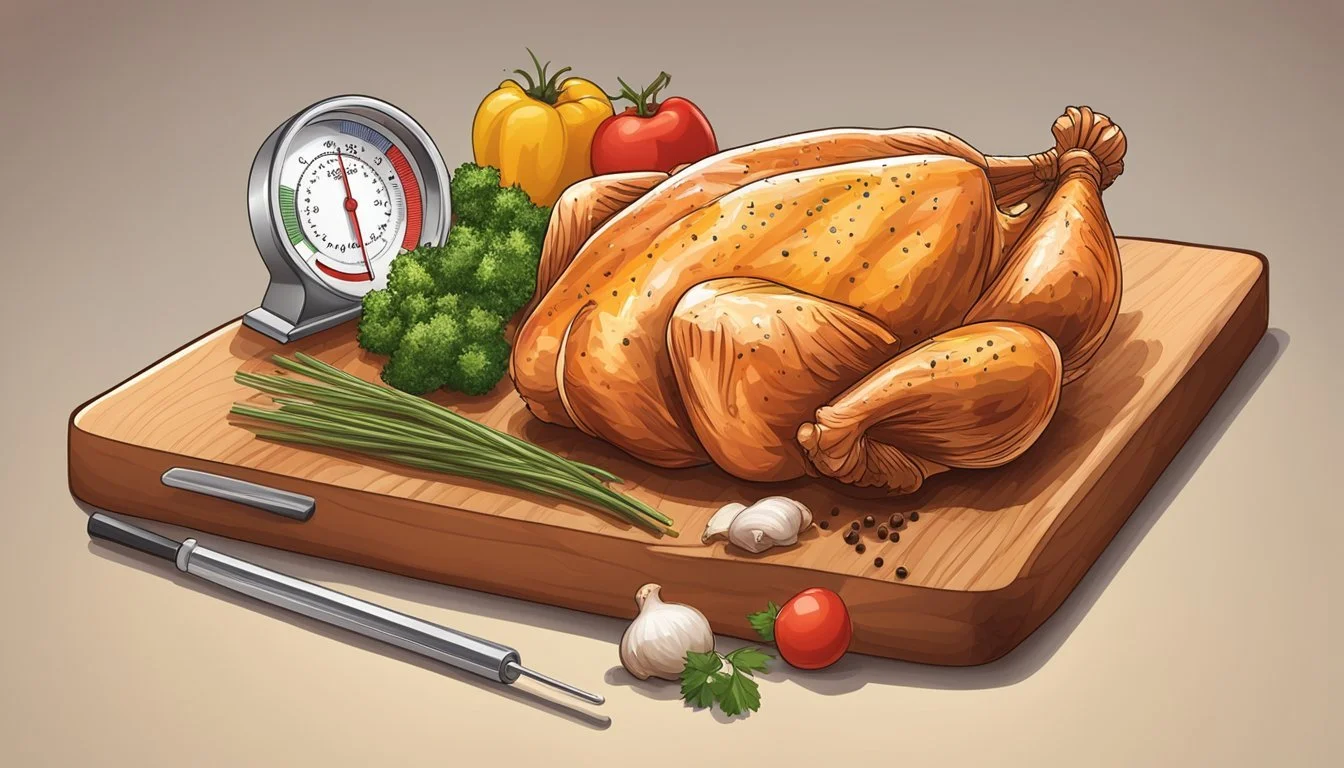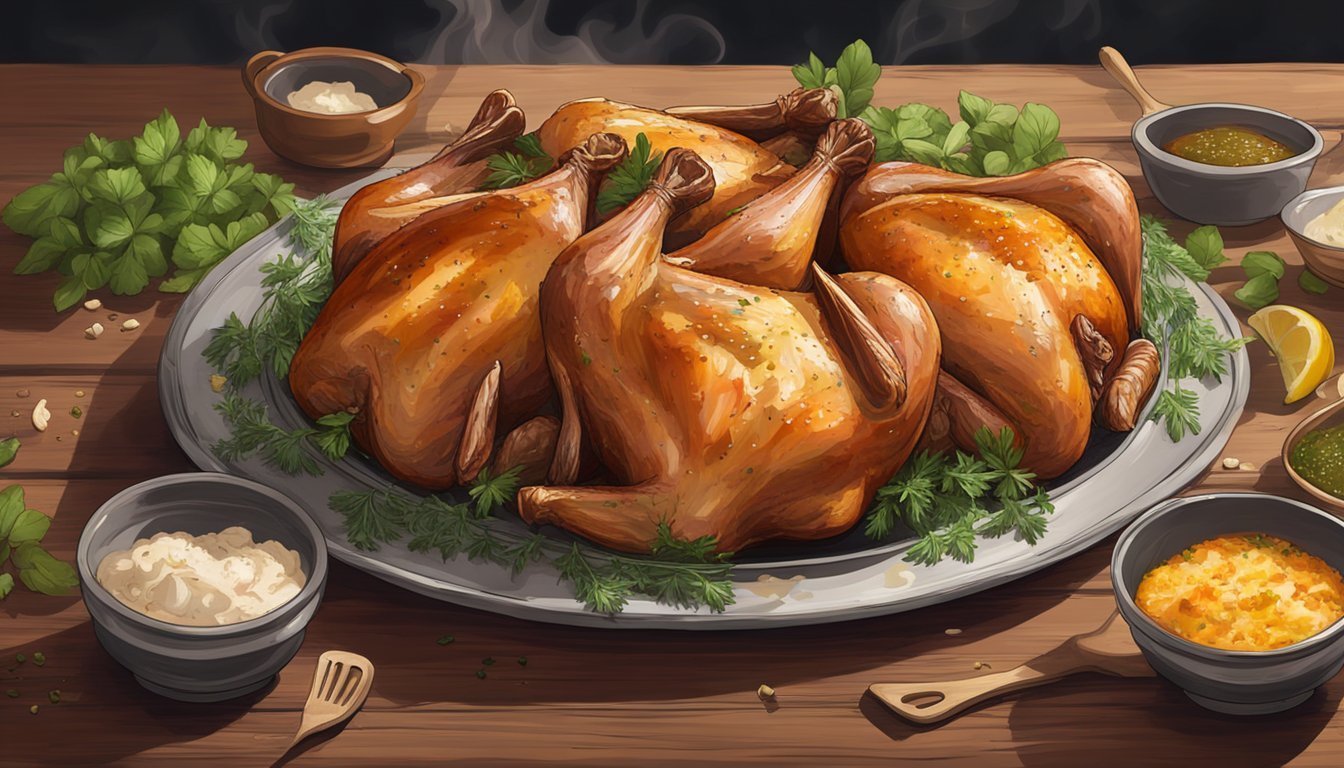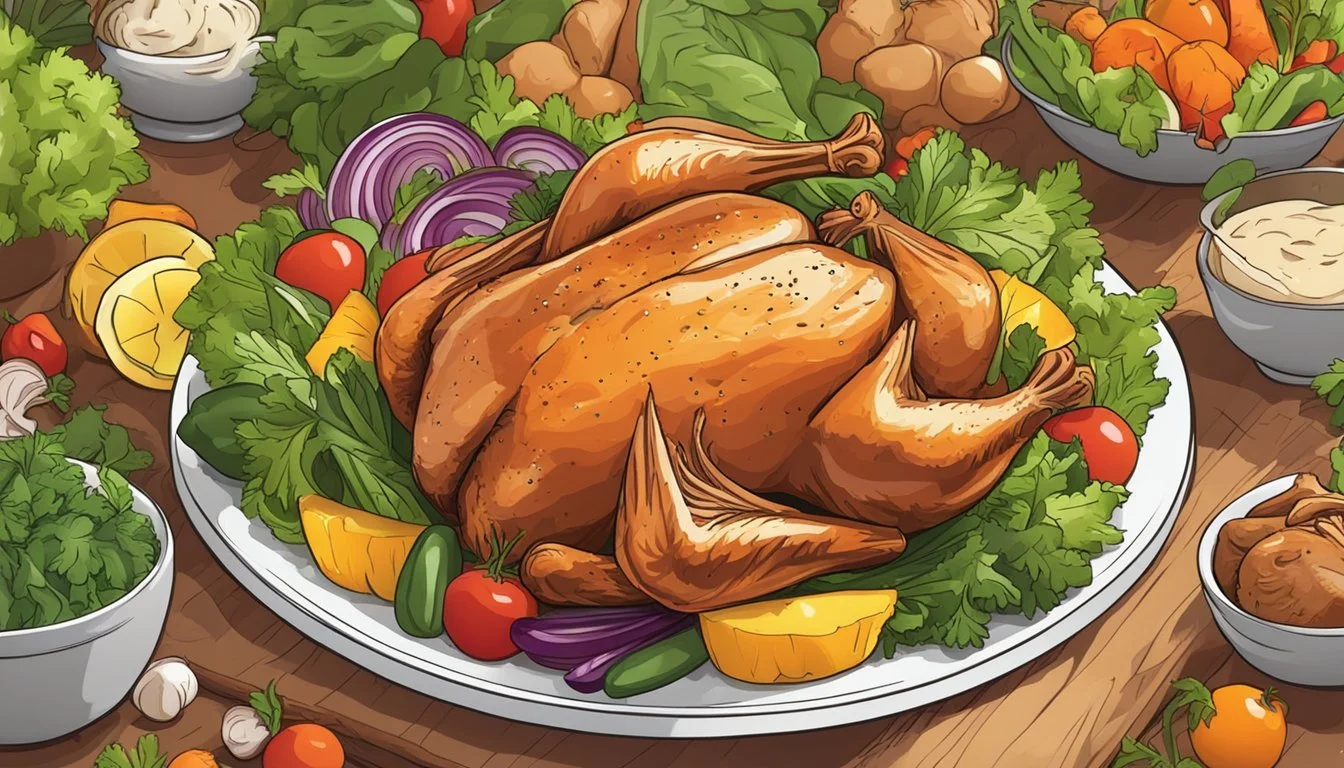Homemade Smoked Chicken Thighs
Step-by-Step Techniques for Perfect Results
Smoked chicken thighs offer a delightful balance of juicy tenderness and rich, smoky flavor, making them a favorite among barbecue enthusiasts. The process of smoking transforms the simple chicken thigh into a mouth-watering dish with a depth of flavor that far surpasses what can be achieved with traditional grilling or baking. The key to perfect smoked chicken thighs lies in the careful balance of cooking temperature, smoke infusion, and seasoning, which work harmoniously to create a savory, succulent piece of meat with a perfectly crisp exterior.
To embark on the journey of homemade smoked chicken thighs, one must start with quality poultry and a suitable smoker. Preparing the thighs begins with a proper brine or rub to ensure that every bite is seasoned to perfection, followed by smoking over chosen hardwoods like hickory, apple, or cherry to impart a subtle, yet distinctive woodsy taste. Temperature control is critical, typically maintaining a low heat to slowly render the fat and lock in moisture, resulting in chicken that is flavorful, moist, and tender to the bone. The final product should be a testament to the skill and patience invested in the process, with each thigh showcasing a rich, golden-brown exterior and succulent meat that pulls away cleanly from the bone.
Understanding Smoked Chicken Thighs
The art of smoking chicken thighs elevates their natural succulence and flavor. This guide provides insights into the meat's structure, the differences between bone-in and boneless varieties, and the advantages that smoking introduces to the palate and nutrition.
Anatomy of Chicken Thighs
Chicken thighs are comprised of dark meat located above the knee joint of the bird. This section is rich in flavor and tenderness, mainly due to a higher fat content and a more significant number of muscle fibers that are exercised during the chicken's lifetime.
Bone-In vs Boneless Thighs
Bone-in chicken thighs generally retain more moisture during the smoking process, contributing to a juicier end product. They also provide a more robust flavor as the bone marrow can infuse into the meat. Conversely, boneless chicken thighs are easier to season and eat, may cook more quickly, and are often preferred for more uniformed recipes where shaping of the meat is important.
Bone-In
Better moisture retention
Enhanced flavor due to bone marrow
Longer cooking time
Boneless
Easier to season and consume
Quicker cooking process
Uniform shape
Benefits of Smoking Chicken Thighs
Smoking chicken thighs imparts a distinctive smoke flavor that cannot be replicated by other cooking methods. The flavor profile is complex and can be influenced by the type of wood used during the smoking process. In terms of nutrition, smoking can be a healthier option since it requires less oil or fat. Additionally, the low and slow technique of smoking allows the fat in the chicken thighs to render out, which can lead to a more enjoyable and texturally pleasing experience.
Preparation Essentials
Before diving into the smoking process, ensuring the chicken thighs are properly prepared sets the stage for flavorful, juicy results. Proper selection, trimming, and brining are key to a great smoked chicken thigh experience.
Selection of Chicken Thighs
The smoker aficionado should always opt for skin-on chicken thighs as they provide a protective layer during cooking, resulting in a juicy interior and a crisp exterior. It is crucial to choose thighs that are approximately the same size for even cooking. Additionally, assessing the quality, always select fresh, plump thighs with a consistent fat distribution.
Trimming and Cleaning
Trimming excess fat and skin ensures an even smoke and crisp texture. Skilled preparers use kitchen shears or a sharp knife to trim excess skin and fat, aiming for a neat, uniform appearance of each thigh. Following the trim, they wash the thighs under cold water and pat them dry. This step is essential for the seasonings and smoke to adhere properly.
Prep Time: Allocate at least 15 minutes for this process in the recipe timeline.
Brining for Enhanced Juiciness
Brining the chicken not only seasons it but also introduces extra moisture, making the thighs extra tender. A simple brine can be concocted using water, salt, and optional sweeteners or aromatics. The chicken thighs should be submerged in the brine and refrigerated for at least 1 hour, but ideally overnight for optimal flavor infusion.
Brine Components Quantity Water 4 cups Kosher salt 1/4 cup Brown sugar 2 tablespoons Optional aromatics Garlic cloves, herbs
Note: A homemade dry rub applied post-brining can further enhance the flavor. A basic rub might include paprika, garlic powder, onion powder, salt, and black pepper—applied liberally over the chicken to coat all sides.
Remember to apply the chosen seasonings or homemade dry rub evenly on the chicken post-brining for a consistent flavor profile. If a barbecue sauce is to be included in the recipe, it should be brushed onto the chicken thighs during the last 20 minutes of smoking to prevent burning and to achieve a perfectly caramelized finish.
Crafting the Dry Rub
When preparing smoked chicken thighs, the creation of a flavorful dry rub is essential. The rub not only imparts taste but also forms a desirable crust on the skin.
Spice Rub Basics
A good spice rub requires a balanced blend of flavors. At its core, it typically includes a combination of:
Paprika: Provides a sweet-peppery base and rich color.
Kosher Salt: Enhances taste and aids in moisture retention.
Garlic Powder and Onion Powder: Offer a savory depth.
Black Pepper: Adds a sharp, piquant note.
Chili Powder: Contributes a subtle heat.
Brown Sugar: For caramelization and a hint of sweetness.
Customizing Your Flavor Profile
The beauty of a homemade rub lies in its adaptability. Customizing is straightforward:
Start with the basic components.
Adjust to personal preference, adding cayenne pepper for heat or additional brown sugar for sweetness.
Consider aromatic herbs such as thyme or oregano for complexity.
Application Techniques
Effective rub application is critical for maximum flavor:
Use a "binder," such as a light coating of mustard or olive oil, to help the rub adhere to the chicken.
Apply the rub evenly, ensuring all surfaces are covered.
For the best results, massage the rub gently into the chicken, then allow it to rest, refrigerated, for a few hours before smoking.
The Smoking Process
The smoking process is integral to infusing chicken thighs with a rich, smoky flavor. One must carefully consider the type of smoker used, wood chips for flavor, and temperature control to achieve the perfect smoke.
Choosing Your Smoker
To smoke chicken thighs, one can use various types of smokers, including electric smokers, pellet grills, and traditional charcoal smokers. Each has its unique advantages:
Electric smokers offer convenience and precise temperature control, ideal for beginners.
Pellet grills utilize compressed wood pellets and provide a balance of ease and flavor, automating the smoking process while still imparting wood-fired taste.
Charcoal smokers offer a more hands-on approach, often favored for the authentic flavor they impart to the meat.
Types of Wood Chips
The type of wood chips used in smoking defines the nuances of the chicken's flavor. Popular options include:
Hickory: Imparts a strong, bacon-like taste.
Apple: Provides a sweet, fruity aroma.
Cherry: Delivers a mild, sweet, fruity flavor.
One may also consider wood chips from pecan or mesquite trees for varied taste profiles.
Mastering the Temperature
Maintaining an optimal temperature is crucial for perfectly smoked chicken thighs. Here are key temperature guidelines to follow:
A stable smoking temperature of 250°F is generally recommended.
Using indirect heat is essential to cook the chicken thighs evenly without burning.
Monitoring the chicken thighs until they reach an internal temperature of 170-175 degrees F ensures they are cooked through and safe to eat.
For optimal results, the smoker's temperature should be checked regularly, and adjustments to the air vents or the addition of more fuel (wood chips, pellets, or charcoal) should be made to maintain ****the desired heat level.
Cooking The Perfect Thighs
Achieving the perfect smoked chicken thighs involves monitoring cook time, checking internal temperature, and ensuring the skin crisps up. Here's how one can manage these aspects for impeccable results.
Managing Cook Time
One should preheat the smoker to a stable temperature of around 250°F to 275°F before introducing the chicken. The cooking time typically ranges between 60 to 90 minutes, depending on the smoker's temperature and the size of the thighs. It’s essential to maintain a consistent smoker temperature to ensure evenly cooked meat.
Checking Internal Temperature
Using a meat thermometer is crucial for ensuring chicken thighs are cooked safely and perfectly. The ideal internal temperature one should aim for is 165°F to 170°F. It is best to insert the thermometer into the thickest part of the thigh, without touching the bone, for an accurate reading. When the thighs reach this temperature, they are done and need to be removed from the smoker.
Achieving Crispy Skin
For crispy skin, one must manage the chicken's exposure to heat. If the smoker allows for direct grilling, finishing the thighs for a few minutes over direct heat can crisp the skin effectively. Alternatively, one could raise the temperature of the smoker towards the end of the cook time to around 275°F to crisp the skin. The skin should be exposed to heat, not covered, to allow it to become crispy. Patting the chicken dry before applying the rub and placing them skin side up during smoking also contributes to achieving a crispy exterior.
Sides and Pairings
The ideal side dishes enhance the smoky flavor of chicken thighs without overwhelming them. They should also balance the richness and texture, creating a cohesive meal experience. This section outlines how to select side dishes that complement smoked chicken thighs and guides you through crafting homemade sauces that bring out the best in your barbecue.
Choosing Complementary Sides
Selecting sides for smoked chicken thighs involves balancing flavors and textures. A starchy component like mac and cheese or potato salad can serve as a rich and comforting base. For a lighter touch, a crisp corn on the cob provides a sweet contrast to the smoky meat.
Classic Sides:
Mac and cheese
Potato salad
Grilled corn on the cob
For those seeking a homemade twist, smoked mac and cheese, enriched with a bbq rub, elevates the classic dish with a smoky depth. It's essential to consider the weight of the sides; a heavy dish pairs well with something refreshing to cleanse the palate.
Added Homemade Twist:
Smoked mac and cheese (with bbq rub)
Homemade Sauce Creations
A well-crafted sauce can accentuate the flavors of smoked chicken thighs magnificently. A basic homemade bbq sauce can be customized with a variety of ingredients to introduce a tangy, sweet, or spicy kick.
Key Components for BBQ Sauce:
Base: Tomato sauce or ketchup
Sweetness: Honey or brown sugar
Acidity: Apple cider vinegar
Spice: Paprika, garlic powder, mustard
To craft a personalized bbq glaze, one might blend a traditional barbecue sauce with a touch of honey and a sprinkle of your favorite bbq rub, simmered until thickened. It's a balance of sweetness, tang, and spice that pairs perfectly with the natural flavors of smoked chicken.
BBQ Glaze Recipe Idea:
Barbecue sauce
Honey
BBQ rub (added to taste)
Simmer until thickened
Finishing Touches
Once the chicken thighs have been smoked to perfection, the final steps are crucial to ensure they're served at their best. These finishing touches, resting and garnishing, lock in the juiciness and set the stage for an eye-catching presentation.
Resting and Serving
The resting phase is integral for the chicken thighs to reach the pinnacle of tenderness. After reaching an internal temperature of 165 degrees Fahrenheit, the smoker's heat gracefully gives way to a wire rack's embrace. One should lay the chicken on the rack, allowing the heat to dissipate slowly and the fibers within the meat to relax, reabsorbing the moisture that makes each bite delectably juicy.
Resting Time: 5-10 minutes on a wire rack
Serving Temperature: Ideally at 170-175 degrees Fahrenheit
Using paper towels, one might gently blot the surface of the chicken to remove any excess moisture that could interfere with the glaze's adherence. A light brush of olive oil can then be applied to add a sheen that makes the dish as inviting to the eye as it is to the palate.
Garnishing for Presentation
To elevate the smoked chicken thighs for any occasion, garnishing plays a paramount role. Whether it's a casual game day or an elegant dinner, a thoughtful garnish can transform the dish from simply homemade to restaurant-quality.
Garnishes to Consider:
Fresh herbs (e.g., parsley or thyme) for a pop of color and freshness
A drizzle of glaze to amplify the flavor and add visual appeal
A sprinkle of finishing salt to enhance taste and texture
Remember that the chosen garnish should not only contrast with the chicken for visual appeal but also complement the flavors developed during the smoking process. A final drizzle of a complementary glaze right before service will ensure the glossy, tempting finish that promises and delivers exceptional flavor.
Advanced Tips and Tricks
For enthusiasts eager to elevate their smoked chicken thighs, mastering advanced tips and tricks can significantly enhance both flavor and technique. This guide will explore unique flavor combinations, refine smoking methods, and identify pitfalls to avoid to achieve pitmaster-level results.
Experimenting with Flavors
To intrigue the palate of any foodie, one must be willing to experiment with a range of flavors. Here are specific steps to amplify the taste profile:
Herb and Spice Blends: Combine smoked paprika and cayenne pepper with other herbs to create a dry rub that imparts a rich, smoky heat.
Smoke Woods: Experiment with different types of wood, such as apple wood for a sweet hint or hickory wood for a stronger, more assertive smoke flavor. Remember that the choice of wood can complement or contrast the chosen spices.
Improving Smoking Techniques
Refining smoking techniques is key to achieving impeccable dark meat texture and moisture:
Smoke at Lower Temperatures: Smoking chicken thighs at around 225°F allows the meat to gradually reach a tender consistency without overcooking.
Skin Management: For a bite-through skin, consider higher smoking temperatures or alternative methods such as a butter bath to achieve the desired texture.
Avoiding Common Mistakes
Awareness of common mistakes is vital for any aspiring pitmaster:
Heat Management: Avoid fluctuating temperatures; maintain a consistent heat to ensure even smoking.
Overcooking: Dark meat, such as chicken thighs, should reach an internal temperature of 170-175°F. Going beyond this can result in dryness. Use a meat thermometer to monitor accurately.
Nutrition and Health Considerations
When preparing homemade smoked chicken thighs, it's important to consider their nutritional impact within a balanced diet. This section will outline key information regarding their caloric content and ways to maintain nutritional balance.
Caloric and Nutritional Information
Chicken thighs are a part of the dark meat category, known for being rich in flavor and tenderness. According to the USDA, a 3.5-ounce serving of boneless, skinless chicken thighs contains approximately:
Calories: 176 kcal
Protein: 24.6 g
Total Fat: 8.8 g
Saturated Fat: 2.4 g
Cholesterol: 138 mg
It's noteworthy that the skin adds additional calories and fat. The smoking process itself does not significantly alter these values but can introduce variability based on the ingredients used in any rubs or marinades.
Balancing Your Meal
Including smoked chicken thighs in a meal requires consideration of what accompanies the protein to ensure a balanced dietary intake. Opt for these healthful pairings:
Whole grains: Options like brown rice or quinoa provide fiber and help balance the meal's macronutrients.
Vegetables: A colorful variety of steamed, grilled, or roasted vegetables can help add vitamins and minerals, as well as fiber.
Healthy fats: A side salad dressed with olive oil can contribute to the intake of unsaturated fats.
When smoked chicken thighs are considered as part of a diverse meal plan, they can contribute positively to an individual's overall nutrient intake while providing enjoyment and satisfaction.
Cleaning and Maintaining Your Equipment
Keeping a smoker or grill in top condition requires consistent cleaning and occasional specific maintenance. Adhering to the following procedures ensures both the longevity of the equipment and the quality of the smoked chicken thighs.
Regular Cleaning Routines
After each use, it is vital to follow a basic cleaning routine for smokers and grills. This prevents buildup and avoids tainting future meals with flavors from old residue.
Pellet Smokers and Grills:
Empty the ashtray and burn pot.
Wipe the interior surfaces lightly with a damp cloth.
Clean the grates with a brush while still warm.
Once cooled, remove ashes from the bottom.
Brush grates and interior surfaces to remove food particles.
Use soapy water for grates as needed, and rinse well.
Gas Grills:
Clean grates with a stiff wire brush.
Regularly check and clean the burners, jets, and igniter.
Wipe down exterior surfaces with a suitable cleaner.
Post-Smoking Maintenance
After the smoking process, taking care of the smoker or grill can prevent rust and ensure functionality for the next session.
All Types:
Allow the unit to cool completely.
Remove and clean all racks, grates, and pans using soapy water; rinse thoroughly.
Scrub any stubborn residue with a scouring pad or grill stone.
Smoker Specifics:
Check seals and gaskets, replacing if they show signs of wear.
Clean out the smoker box or tray, removing residue and spent materials.
Long-Term Smoker Care
A more thorough inspection and cleaning should be routinely scheduled to sustain the smoker or grill's condition over time.
Pellet Smokers:
Annually, clean out the auger system to prevent pellet jams.
Inspect the hopper for any moisture which could spoil the pellets.
Charcoal and Gas Grills:
Deep clean once a season, checking for any rust or corrosion.
Oil metal parts to protect from the elements.
By regularly maintaining cleaning routines and focusing on long-term care, one's smoker or grill will remain a reliable tool for crafting delicious smoked chicken thighs and other barbeque delicacies.
The Social Aspect of Smoked Chicken Thighs
Smoked chicken thighs are a versatile main dish that have become a staple at social gatherings. They offer a perfect balance of savory smoke, juicy meat, and are adaptable to suit various tastes.
Hosting a Backyard BBQ
A backyard BBQ shines with smoked chicken thighs as the centerpiece. These delectable pieces of poultry are a hit for several reasons:
Flavor: The combination of natural wood smoke and a crafted rub provides layers of taste.
Variety: Guests can enjoy different cuts, such as chicken legs and thighs, each with its unique texture and degree of savoriness.
Adaptability: Chicken thighs easily take on the flavors of a variety of woods—oak, hickory, or fruitwoods—used in smokers like a Traeger.
How to Serve:
Present the chicken directly off the smoker, allowing guests to experience the aroma.
Create a self-serve station with sides and sauces, encouraging guests to customize their plate.
Cooking for a Crowd
When preparing smoked chicken thighs for a crowd, consider the following:
Quantity: Estimate at least two thighs per person; this accounts for both hearty eaters and those who prefer smaller portions.
Preparation: Smoking multiple thighs is efficient. A smoker can handle large batches, which is cost-effective and space-efficient.
Tips for Success:
Use a consistent temperature, ideally around 250˚F, ensuring even cooking.
Monitor internal temperatures, aiming for 165-170˚F for optimal tenderness and safety.
Allow for a rest period after smoking; it lets the juices redistribute, making every bite succulent.
Cooking smoked chicken thighs for a gathering requires organization and attention to detail, but the result is a mouthwatering feast that satisfies a diverse group of diners.
Conclusion
Mastering the art of smoking chicken thighs necessitates attention to detail and patience. Heat, smoke, and time are the pillars for transforming simple chicken thighs into a flavorful delicacy.
By maintaining the smoker at an optimal temperature, usually between 225-250 degrees F, and selecting the right wood for smoke, such as hickory or apple, anyone can achieve that perfect balance of succulent and smoky.
The process involves:
Preparation: Ensuring chicken thighs are patted dry and seasoned with a rub that complements the natural flavors.
Smoking: Cooking the meat at a consistent temperature until it reaches the safe internal temperature of 165 degrees F.
Resting: Allowing the meat to rest for a short period after smoking ensures juices redistribute for optimal tenderness.
Home cooks should remember that each step is crucial, and shortcuts may lead to less desirable results.
One might also consider brining the chicken to add moisture and flavor, but it is not strictly necessary. The desired outcome rests on personal preferences and the willingness to experiment with different techniques and seasonings.
The keys to success in smoking chicken thighs lie in the basic principles outlined here. With regular practice, anyone can refine their technique and develop their signature smoked chicken dish.








